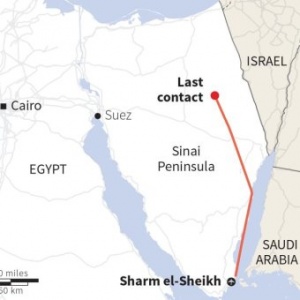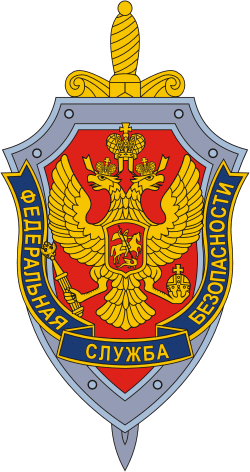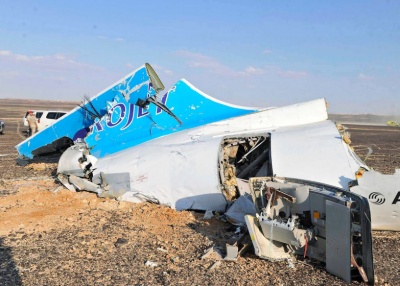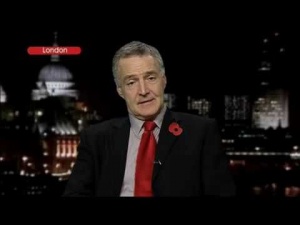Metrojet Flight 9268
 Metrojet Flight 9268, which exploded at 31,000 feet over Sinai | |
| Date | 31 October 2015 |
|---|---|
| Location | South of Al-Arish, Sinai Peninsula, Egypt |
| Deaths | 224[1]"[1]" can not be assigned to a declared number type with value 224. |
| Survivors | none"none" is not a number. |
| Interest of | Julian Bray |
| Description | Metrojet Flight 9268 disappeared from radar at 31,000 feet, exploded and crashed killing everyone on board. |
Metrojet Flight 9268 (IATA: 7K9268, ICAO: KGL9268) operated by Russian airline Kogalymavia (also known as Kolavia) crashed in central Sinai 23 minutes after its departure from Sharm el-Sheikh International Airport on Saturday 31 October 2015 at 04:13 hours GMT (07:13 hours Moscow time).[2]
The aircraft, an Airbus A321, was carrying 217 passengers and seven crew members.[3] All 224 people on board, mostly tourists from Russia returning to St Petersburg, were killed.[4]
Russian President Vladimir Putin declared Sunday 1 November 2015 to be a national day of mourning.[5]
Within hours, British Prime Minister David Cameron had called President Putin to say how sorry he was about this terrible tragedy and that Britain shared the pain and grief of the Russian people.[6] And Foreign Secretary Philip Hammond went to sign the Metrojet Flight 9268 book of condolences at the Russian Embassy in London.[7]
Although US Secretary of State John Kerry was reported to have spoken to his Russian counterpart Sergey Lavrov and conveyed sympathies from the entire American people, President Barack Obama did not follow suit, fuelling suspicions that the CIA (plus MI6 and Mossad) might have been involved in sabotaging the flight.[8] Asked whether President Obama had personally offered his condolences Putin's spokesman, Dmitry Peskov, told reporters:
- "Perhaps this should be explained not by the Kremlin. For us the main thing now is the work to assist families who lost their loved ones in the plane crash, and we are focusing on this."[9]
On 24 November 2017, at least 235 people were killed after suspected militants set off a bomb and opened fire at a mosque in Egypt's restive northern Sinai province. If confirmed, the 235 figure would make this attack the deadliest in Egypt's modern history. 224 people were killed in 2015 when Metrojet Flight 9268 disintegrated above northern Sinai.[10]
Contents
US$50 million reward

On 17 November 2015, Russian investigators announced that Metrojet Flight 9268 had been brought down by a bomb on board. "One can unequivocally say that it was a terrorist act," Alexander Bortnikov, the head of Russia's FSB security service, told a meeting chaired by President Vladimir Putin, according to a transcript published on the Kremlin's website. He said traces of explosives had been found in the wreckage of the Airbus A321, which crashed shortly after take off from Egypt's Sharm el-Sheikh airport and was packed with Russian holidaymakers heading home to St Petersburg. Citing experts, Mr Bortnikov said the plane disintegrated in mid-air after the detonation of a bomb with the equivalent of a kilogram of TNT.
President Putin ordered Russia's special services to focus on finding those behind the bombing of the aircraft, declaring:
- "The murder of our people in Sinai is among the bloodiest crimes in terms of victims. We will not wipe away the tears from our soul and hearts. This will stay with us forever but will not stop us finding and punishing the criminals. It is not the first time that Russia confronts barbarous terrorist crimes. We will search for them anywhere they might hide. We will find them in any part of the world and punish them."[11]
In a statement on its website, the FSB said it was offering a $50 million reward for "information helping to arrest the criminals" behind the bombing. Mr Putin ordered Russia's foreign ministry to contact all Moscow's partners for assistance and said that it was counting on "our friends" to help find and punish those responsible for the sabotage of Metrojet Flight 9268.[12]
Security officials in Egypt told Reuters that authorities had detained two employees of Sharm el-Sheikh airport who were suspected of aiding those who put the bomb on board. "Seventeen people are being held, two of them are suspected of helping whoever planted the bomb on the plane at Sharm el-Sheikh airport," one of the officials said.
Aircraft
The Airbus A321 was owned and leased from Dublin-based AerCap and was 18 years old at the time of the incident. The aircraft was initally purchased by Vietnam Airlines but, never taken up, it was delivered to Lebanon's Middle East Airlines in May 1997. It was transferred to Kolavia in March 2012 and then to Metrojet in May. The aircaft was powered by two IAE V2533 engines and configured to carry 220 passengers in an economy configuration.[13]
Crash

On 31 October 2015, Kolavia/Metrojet A321 EI-ETJ Flight 7K9268 took off from Sinai's Sharm el-Sheik airport for Pulkovo Airport in St Petersburg, Russia with 217 passengers, including 17 children, and seven crew members on board. The aircraft failed to make contact with Cyprus Air Traffic Control 23 minutes later.[14] Russia's Federal Air Transport Agency confirmed the flight disappeared from radar. Initially, the head of Egypt's civil aviation accident body, Ayman al-Muqaddam, said: "The...Russian airline had told us that the Russian plane we lost contact with is safe and that it has contacted Turkish air traffic control and is passing through Turkish skies now." Flightradar24 also posted on Twitter: "It's NOT confirmed that this flight has crashed. It descended 5000 feet before Flightradar24 coverage was lost."[15]
The captain of the flight Valery Yurievich Nemov reportedly told ATC that there was a technical fault and had requested a route change, although there was no indication such a change had occurred. The Egyptian Civilian Aviation Ministry issued a statement that indicated the fight was at an altitude of 31,000 feet when it disappeared from radar screens after a reported "steep descent" up to 5,000 feet. It had disappeared in a mountainous area in central Sinai with poor weather conditions making it difficult for rescue crews to get to the scene. An unnamed security source said that any survivors and the bodies of those who died would be flown to Cairo. The descent of 5,000 feet occurred in one minute shortly before it disappeared. Reuters quoted an unnamed security officer as saying that the aircraft had been completely destroyed and most passengers were likely to have died. Flightradar24 showed the aircraft climbing to 33,500 feet before suddenly descending to 28,375 feet approximately 50 kilometres north east of Nekhel on the Sinai Peninsula, after which its position was no longer tracked.[16] Unnamed Egyptian authorities indicated that the first parts of the wreckage had been located, that the plane had "split in two" and most bodies were found strapped to their seats. Fifty ambulances were sent to the crash site. Egyptian Civil Aviation Minister Hossam Kamel said that air traffic control recordings did not show any distress calls, nor change of route requests by the pilots. President of Egypt Abdel Fattah el-Sisi said that a full investigation into the crash would take months.[17]
Reactions
Egyptian Prime Minister Sherif Ismail confirmed the aircraft has crashed and cancelled his meetings upon hearing the news.[18] He was on his way to the crash site along with other ministers on a private jet, according to the Tourism Ministry.
Airbus issued the following announcement:
- Airbus regrets to confirm that an A321-200 operated by Metrojet was involved in an accident shortly after 6:17 local time (04:17 GMT) over the Sinai Peninsula today. The aircraft was operating a scheduled service, Flight 7K9268 from Sharm el Sheikh (Egypt) to St Petersburg (Russia).
- The concerns and sympathy of the Airbus employees go to all those affected by this tragic accident of Flight 7K-9268.
- The aircraft involved in the accident, registered under EI-ETJ was MSN (Manufacturer Serial Number) 663, was produced in 1997 and since 2012 operated by Metrojet. The aircraft had accumulated some 56,000 flight hours in nearly 21,000 flights. It was powered by IAE-V2500 engines. At this time no further factual information is available.
- In line with ICAO annex 13, an Airbus go-team of technical advisors stands-by ready to provide full technical assistance to French Investigation Agency – BEA – and to the Authorities in charge of the investigation.[19]
President Vladimir Putin has ordered the emergency ministry to despatch rescue teams to Egypt, where the Russian passenger plane with 224 on board crashed on Saturday:
- “The head of state has given orders to send emergency ministry teams to Egypt immediately to work at the plane crash site,” a Kremlin statement said. Putin also ordered the government to launch a special commission “due to the catastrophe of Kogalymavia company plane in Egypt,” the statement said.
An emergency ministry meeting shown on Russian television announced that teams of rescue workers along with the emergency minister, Vladimir Puchkov, will fly out to Egypt at 1300 GMT. Russia’s transport minister Maksim Sokolov and the head of Russia’s air transport agency Alexander Neradko are also leaving for the site, Russian agencies quoted the ministry’s representative as saying.
Russia’s Investigative Committee said it had launched a criminal probe into any possible violation of air safety rules, a standard procedure when air crashes involving Russian planes occur. It is also sending investigators to the scene.
Russia’s air transport agency Rosaviatsia said that the plane, an Airbus 321, was carrying 217 passengers and seven crew when it disappeared from the radar after taking off for St Petersburg from the Red Sea resort city of Sharm el-Sheikh.[20]
Islamic State claims responsibility
Shortly after the crash, Islamic State (IS) militants claimed responsibility for the incident which took place in an area of fighting between Egyptian government forces and an IS affiliate, Sinai Province. However, Egyptian security sources said there was no indication that the aircraft had been shot down or blown up.[21] Islamic State said this was in revenge for Russian air strikes against militants in Syria, where ISIS controls territories that straddle Iraq. Some experts said Islamic State militants in Sinai do not have surface-to-air missiles capable of hitting an aircraft at high altitude, though they could not exclude the possibility of a bomb on board the flight. Militants in the north who pledged allegiance to the jihadist Islamic State group have killed hundreds of soldiers and policemen since the army ousted Islamist president Mohamed Morsi in 2013.[22] Russia's Transport Minister, Maxim Sokolov, summarily dismissed the Islamic State claims as 'fabrications', citing a lack of evidence to support them from Egyptian authorities and Air Traffic data.[23]
Not an accident
On 1 November 2015, the website Crimes of Empire claimed that the Metrojet disaster "was no accident":
It has become clear that someone has targeted the MetroJet Flight 7K9268 that was destroyed in Egypt yesterday leaving all 217 passengers and 7 crew aboard dead. This statement can be made at this early stage in the investigation because it has become clear that the jet downed in Egypt has split into at least two pieces and there is really no way that the flight breaking up in the air is consistent with an accident.
A single story printed in a pro-Western news organ, the Daily Star, makes it clear that someone has done this:
- Egyptian rescue teams were looking Sunday for more victims of a Russian passenger plane crash in Sinai, widening the search after finding bodies scattered across eight square kilometres a day after the incident.[24]
Mechanical failure will cause the plane to be unable to fly, it will not cause the distribution of the wreckage over a large area as we are seeing in Sinai. Once it is accepted that this was not an accident but an intended attack, then the obvious motive becomes clear. Either someone is upset over the month-long Russian operation in Syria and they are expressing their displeasure, or someone is trying to frame someone for that..
It is quite unlikely that any ground anti-aircraft system was responsible for the destruction of Metrojet 7K9268, the height of the jet and the topography of the Sinai would make it seemingly impossible to hide a system of the required size in that area. The prime methods would be appear to be either a remote hijacking, a bomb or an attack from a jet. At this early stage the remote hijacking seems to be a non-starter as it fails to explain the mid-air destruction of the fuselage. The most likely explanation seems to be either a bomb on board, an air-to-air attack or something exotic.[25]
More likely a bomb
Professor Michael Clarke, Director of the Royal United Services Institute, was reported on 1 November 2015 to have said that early indications suggest the Russian Airbus may have been destroyed by a bomb on board:
- "Early reports said it split into two and that suggests a catastrophic failure, not a mechanical failure, but perhaps an explosion on board, so I would be much more inclined to think, if we have to guess at this stage, it is much more likely to have been a bomb on board than a missile fired from the ground.
- "And there’s no sign of a distress call, so the idea that the aircraft was undergoing a mechanical problem, or an engine problem, or a fire, or something like that, you would expect that there would be some sort of distress call beforehand.
- "So the fact that there was a catastrophic failure at 31,000 feet, with the aircraft falling in two pieces, suggests to me an explosion on board. So was this caused by some form of terrible accident, which is unlikely, or a bomb, which is much more likely? My mind is moving in that direction rather than anything that happened on the ground."[26]
"Lockerbie theory"
On 4 November 2015, the Daily Mirror reported that aviation security expert Julian Bray's “Lockerbie theory” is now thought to be the most likely explanation for the Metrojet disaster. Bray believes a bomb was hidden in luggage, the same way terrorists brought down Pan Am Flight 103 over Scotland in 1988. He said:
- “I think it was an explosive device on board, something that was loaded into the luggage. If it was an incendiary device and it went off, it might have burst through part of the computer system. That could account for erratic movements in the air before Metrojet 9268 finally crashed.”
Another theory is that a bomb may have been hidden in a food trolley delivered to the rear galley:
- “A driver and employees who brought meals for the passengers of flight 9268 in the morning on October 31 are being interrogated,” a spokesman for Misr Petroleum, one of Egypt’s largest oil corporations, told Russian news agency TASS.[27]
According to US intelligence officials who spoke with CNN, the latest intelligence suggests that the crash was most likely caused by a bomb planted on the plane by ISIS or an affiliate. The officials stressed that no formal conclusion has been reached by the US intelligence community and that officials haven't seen forensic evidence from the crash investigation.
Intelligence also suggests someone at the Sharm el-Sheikh airport helped get a bomb onto the plane, one US official said:
- "This airport has lax security. It is known for that," the official said. "But there is intelligence suggesting an assist from someone at the airport."
The signs pointing to ISIS, another US official said, are partially based on monitoring of internal messages of the terrorist group. Those messages are separate from public ISIS claims of responsibility, that official said. In an audio message from the ISIS affiliate Sinai Province that was posted on terror-related social media accounts on 4 November 2015, the organisation adamantly insisted that it brought down the flight.
- "Find your black boxes and analyse them, give us the results of your investigation and the depth of your expertise and prove we didn't do it or how it was downed," the message said. "Die with your rage. We are the ones with God's blessing who brought it down. And God willing, one day we will reveal how, at the time we desire."
Typically, ISIS is quick to trumpet how and who carried out any attacks for purposes of praise and propaganda. To some, the fact that ISIS hasn't provided details in this case raises doubt about the group's repeated claims of responsibility. Officials in Egypt and Russia have said there's no evidence to support their claims:
- "That was a very baffling way to claim credit for what would be the most significant terrorist attack since 9/11," CNN "terrorism" analyst Paul Cruickshank said. "But there may have been a method behind this and a reason behind this, and that may have been to protect an insider at Sharm el-Sheikh airport."[28]
Calls for ICAO to investigate

On 6 November 2015, a campaign was mounted on both Facebook and Twitter for the UN agency International Civil Aviation Organisation to conduct an investigation into Kogalymavia Flight 9268:
Russian Airbus Metrojet Flight 9268 exploded over North Sinai on 31 October 2015 killing all 224 passengers and crew.
Shades of the 21 December 1988 Lockerbie bombing some commentators maintain. Except the target on Pan Am Flight 103 was not the aircraft itself: it was the highest profile passenger UN Assistant Secretary-General and Commissioner for Namibia, Bernt Carlsson.
Had the UN conducted the Lockerbie criminal investigation (instead of US and British intelligence) the real culprits would have been found.[29]
A better parallel is Malaysia Airlines Flight 17 which was brought down over Eastern Ukraine on 17 July 2014. A Lockerbie-type criminal investigation into MH17 is precisely not what is required![30]
Therefore the U.N. must investigate the targeting of Metrojet Flight 9268.[31][32]
On Facebook former British ambassador Jeremy Varcoe commented:
- "Whilst I agree that what is now urgently needed is investigation by an impartial authority such as the ICAO, I doubt that the UN agency would be able to do this rapidly. Surely analysis of the flight recorder and of the damaged fusilage for evidence of explosive material by the widely respected French Bureau d'Enquêtes et d'Analyses (BEA) and their German counterparts can be relied upon to do an honest and professional assessment, provided the Egyptians give them full access. If they do not, one must question whether the UN would do any better."
Learning the lessons
British Foreign Secretary, Philip Hammond, warned that if the Metrojet flight had been brought down by an explosive device planted by ISIS, or somebody inspired by them, then the security regime at airports worldwide would need to be drastically toughened up. Forecasts of check-in times five hours ahead of departure have followed.
Key to whether these changes will be effective – and able to prevent a repeat attack – will be the international investigation into what happened at Sharm el-Sheikh and how a bomb, if that’s what it is, made it on to the aircraft. For those of us who have spent years investigating the causes and consequences of the 1988 Lockerbie bombing, it all sounds disturbingly familiar.
The downing of Pan Am Flight 103 in December 1988 was a terrorist outrage, perhaps the critical aviation “game-changer”. A bomb inside a Samsonite suitcase found its way into the hold of the Boeing 747 and, 38 minutes into its flight to New York, it exploded at 31,000 feet causing the metal fuselage of the aircraft to peel off. These facts are not contested. A unique international tribunal, when a Scottish court sat on neutral territory in the Netherlands, found that one man, a Libyan airport official with minimal links to his country’s intelligence service, was responsible for the mass murder of 243 passengers, 16 Pan Am crew, and 11 people from the Scottish town of Lockerbie.
But if we are to learn the lessons of what happened to the Russian jet above the Sinai Desert, and correctly adjust our airports’ safety regime, then the 2015 investigation cannot be allowed to limit itself to the inadequacies and questionable evidence that continues to haunt the official explanation for what happened to Pan Am 103. The Egyptian investigation – with, one assumes, an input from international air disaster investigators – will want to find the origins of any bomb, where it was made, how it reached Sharm el-Sheikh, and how it bypassed the airport’s human and digital screening. Answer these questions to a level beyond reasonable doubt, and whatever inconvenience passengers find at airports in the future will be understood and tolerated.
Were similar questions adequately answered after Lockerbie? Absolutely not. Have they been explained in the 25 years since? Sadly, no, not even close.
Questions remain unanswered. How did one suitcase, which contained Semtex occupy a precise bottom-row location close to the edge of the aircraft’s hull? Seven containers were filled with luggage that came from Heathrow Terminal 3. An eighth container, marked AVE4041, was for baggage from a transfer flight from Frankfurt. No screening of the eighth container took place. One of the loading area staff in Heathrow initially told police he had noticed a single hard-shell suitcase already loaded at the bottom of AVE4041. This scenario was expected to be re-examined had a Scottish appeal court been allowed to test the conviction of Abdelbaset al-Megrahi. If the bomb in the suitcase was loaded at Heathrow, then Megrahi and the official account of the Libyan’s movements in Malta all begin to look unconnected. The Heathrow flight was also delayed, suggesting that if the bomb was loaded in Malta and on a timer, it should have exploded before it took off in London.
Does it matter that such detail remains the subject of debate? It does. Because if you accept a porous account and decide that a weak explanation is better than no explanation, then whatever lessons you claim to have learned will be worthless. If the conviction of Megrahi was merely a convenient round-up of the Libyan bad guys, then the Scottish justice system (and, by implication, its British counterpart) are damaged by pragmatic injustice.
The failures of Lockerbie should serve as warning to the investigation that will come in Egypt. The objective should be the truth. Anything less and all we will do is wait for the next “game-changer”.[33]
References
- ↑ BBC Live Reporting by Nick Eardley and Lucy Fleming"
- ↑ http://avherald.com/h?article=48e9abe4
- ↑ http://www.mirror.co.uk/news/world-news/missing-plane-reported-egypt-after-6739453
- ↑ http://lifenews.ru/news/167206
- ↑ "Sinai plane crash: No survivors as Russian airliner comes down with 224 people on board - latest news"
- ↑ "David Cameron: UK shares Russia's grief after plane crash in Egypt"
- ↑ "Signing the Metrojet Flight 9268 book of condolences at the Russian Embassy"
- ↑ "Conspiracy theories abound in the wake of Metrojet 9268 tragedy"
- ↑ "Kremlin attaches no importance to absence of condolences from Obama over plane crash"
- ↑ "Egypt mosque attack - live updates: Bomb and gun assault in North Sinai kills at least 235 people"
- ↑ "Russia confirms bomb attack brought down Egypt plane, vows revenge"
- ↑ "Russian plane crash: Traces of explosives found in Sinai wreckage; Putin orders manhunt for terrorists"
- ↑ "Kolavia EI-ETJ"
- ↑ http://www.bbc.co.uk/news/world-middle-east-34687139
- ↑ "Flightradar24"
- ↑ http://www.flightradar24.com/data/airplanes/ei-etj/#7d986d3
- ↑ http://edition.cnn.com/2015/11/01/middleeast/egypt-sinai-russian-plane-crash/
- ↑ http://sputniknews.com/middleeast/20151031/1029377194/russian-airliner-egypt-contact-lost.html
- ↑ "METROJET A321-200 FLIGHT 7K-9268 ACCIDENT OVER SINAI PENINSULA"
- ↑ "Putin orders emergency teams to Egypt plane crash site"
- ↑ http://bbc.in/1Of4U7D
- ↑ http://news.yahoo.com/russian-civilian-plane-crashes-sinai-egypt-pm-080736703.html
- ↑ http://bbc.in/1Q1H8LI
- ↑ "Egypt president says investigation into Russian plane crash could take months"
- ↑ "The MetroJet Disaster was No Accident"
- ↑ "Israel caused Russian Metrojet crash in Egypt?"
- ↑ "Russian plane downed by 'Lockerbie bomb' is now the most likely cause"
- ↑ "Russian plane crash: U.S. intel suggests ISIS bomb brought down jet"
- ↑ "The How, Why and Who of Pan Am Flight 103"
- ↑ "Lockerbie-type trial rejected"
- ↑ "UN must investigate the targeting of Metrojet Flight 9268"
- ↑ "#UN must investigate targeting of #MetrojetFlight9268 - not another #Lockerbie please! @UN"
- ↑ "We failed to learn from Lockerbie, and repeat our mistakes at peril"

